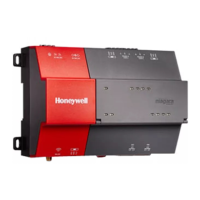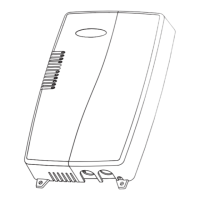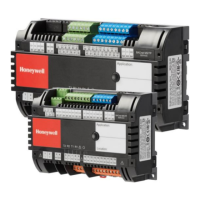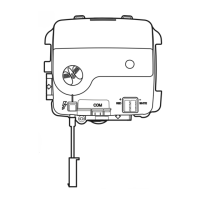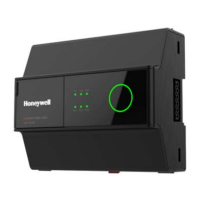WEB-700 WEB-700-O CP-700
17 95-7776—01
WEB-700; WEB-700-O; CP-700
NOTE: If rebooted with the mode jumper in the “Serial Shell” position (see Fig. 5, page 11), the RS-232 port provides “system
shell” access. See the NiagaraAX Install and Startup Guide for related details.
.
RS-485
An RS-485, optically isolated port is available on 3 pins of the 6-position right-side connector, and always operates as COM2. As
shown in Table 4, the screw terminals are minus (–), plus (+), and shield. Wire in a continuous multidrop fashion to other RS-485
devices, meaning “minus to minus”, “plus to plus,” and “shield to shield.” Connect the shield to earth ground at one end only, such
as at the WEB/CP-700.
USB
Two USB-2.0 ports are standard on a WEB/CP-700 controller. These ports are “stacked” together, located on the top side—see
Fig. 7, page 16.
NOTE: Both USB ports are “low current” ports, capable of supplying up to 100 mA at 5V, maximum.
A typical application for a USB port is to use with a “USB Flash drive” for the transfer of files. The QNX OS running on the WEB/
CP-700 can automatically recognize an inserted Flash drive as a physical disk.
Grounding
An earth ground spade lug (0.187") is provided on the controller for connection to earth ground. For maximum protection from
electrostatic discharge or other forms of EMI, connect the supplied earth grounding wire to this lug and a nearby earth ground.
Keep this wire as short as possible, see Fig. 8.
Table 4. Serial port (RS-232 and RS-485) pinouts.
Base RS-232 DB-9 Port (COM1) Base RS-485 Port (COM2)
Pinout Reference Signal DB-9 Pin Pinouts
DB-9 Plug (male) DCD Data carrier detect 1 6-Position end connector (male)
RXD Receive data 2
TXD Transmit data 3
DTR Data terminal ready 4
GND Ground 5
DSR Data set ready 6
RTS Request to send 7
CTS Clear to send 8
not used on the 7 9
PS – (GND)
PS + (15V)
BB (12V Batt)
–
+
S
RS-485
Power
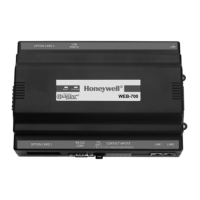
